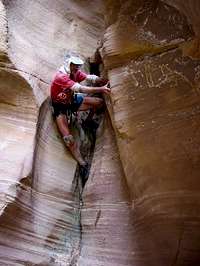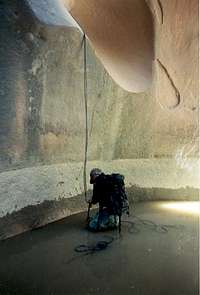|
|
Area/Range |
|---|---|
|
|
Trad Climbing, Bouldering, Scrambling, Canyoneering |
|
|
Spring, Summer, Fall, Winter |
|
|
Slot Canyons: What are They, and What Does This Page Include?
Slot canyons are very narrow canyons that are much deeper than they are wide. Many slot canyons are so narrow that you can touch both walls at the same time, even though the canyons have perpendicular walls and are often hundreds of feet deep. Some canyons are narrow enough that you have to squeeze through, while others are so narrow that you can’t fit through at all. These slot canyons are some of the most spectacular and interesting geological features in the world.
The definition of technical canyon varies from group to group and person to person, but basically, these are canyons that require rock climbing skills to ascend or descend. The line gets fuzzy when describing a technical canyon when it just requires rappelling and not any other rock skills. I tend to take the side that canyons just requiring some rappel is not really challenging enough to be technical canyons. There must be challenging climbing (either up or down) as well. Some of these canyons are far more difficult than many mountains, and in fact all my most difficult climbing trips have involved canyons.
This group page was created to separate the technical canyons from the others to aid in searching for this type of canyon trip. This page is only for slot canyons within the Colorado Plateau.
Introduction to Colorado Plateau Slot Canyons
The Colorado Plateau is the Canyoneering Mecca of the world. There are more slot canyons located here than anywhere else. A rough guess is that there would be more than 10,000 technical canyons in the region, but this is just a wild guess.
The Colorado Plateau consists of large portions of Utah, Colorado, New Mexico, and Arizona. Utah has the most slot canyons, followed by Arizona. Colorado and New Mexico have many, but the vast majority are in Utah and Arizona.
Skills Required
These canyons all require technical rock climbing skills, as well as natural anchoring skills. Sometimes in wet sandstone, you can pull out pitons or bolts with your bare hands. Natural anchors are the way to go in most situations, but even then, you must use extreme caution. Sometimes even “bomb-proof” chockstones explode when weighted.
Technical Canyoneering is often more risky than technical rock climbing. The reason is that is more committing because once you start a technical canyon route, it is usually much more difficult to reverse. Use extreme caution before you pull your ropes.
Flash Floods
These are not to be taken lightly. A quarter inch of rain is enough water to send a deadly flash flood down a slot canyon. Most of these canyons drain huge slickrock area, and often there is no soil or vegetation to absorb the water. Sometimes you will noticed logs wedged 100 feet up between canyon walls. Want to guess how they got there? If a flash flood does hit you in a canyon, sometimes bodies are not found. Pieces of bodies, maybe. Imagine being dragged across sandpaper by rushing water, over waterfalls, into narrow constrictions, and over boulders. Yeck. The moral of the story is, always have a good weather forecast before dropping into a slot canyon.
Click here for a story of a deadly flash flood in one of these canyons
Other Dangers and Hazards
Other than the standard dangers associated with rock climbing or flash floods, Canyoneering throws some more extra dangers into the mix that you won’t find on your standard rock climbs. Fortunately for most, the majority of technical slot canyons only require standard rock climbing skills. These are the canyons that are most popular. In other canyons, though, some unusual, difficult, exciting, and dangerous obstacles are present. Below are a few that you may encounter.
Keeper Potholes:
Imagine this. You are climbing down a slot canyon, and pull your rope after a big rappel. You continue down canyon and there is a huge hole in the canyon floor. It is 30 feet deep, has water at the bottom, and is overhung on all sides. The only way to continue is to rappel into the pothole and climb up the other side. You had better know how to get out. If you rap in, and can’t start the climb out while treading water, or if you can’t reverse the route, you will die; it’s as simple as that. Such techniques are beyond the scope of this page, and you must learn them before doing either a known canyon that is full of keeper potholes.
Example of a infamous canyon with "keeper potholes"
Mae West Obstacles:
This term was coined by the Steve Allen crew. Such canyons are those which pinch down so they are too narrow to squeeze through. See also this photo. You must climb up and over the constriction, and then down climb to the other side. Imagine this. A canyon pinches down and becomes too narrow to squeeze through. You chimney 30 feet above the obstacle and continue down canyon horizontally, and staying above the constriction for 1000 feet horizontal distance. The canyon widens and you must climb down. Unfortunately, the canyon bottom has been dropping lower since you have been moving horizontally. You now have two feet on one wall of the canyon, and your hands on the other side. You are now staring straight down 80-100 feet, unroped, with no protection. Now you have to down climb. Since you are moving horizontally for a distance of 1000 feet on very damp and soft rock, protection from bolts or pitons is impossible. You had better be prepared......
Example of a canyon with "Mae West obstacles"
Click here for the story of a near disaster in a "Mae West" type canyon
Silos:
Arguably, the most feared and dangerous obstacles of slot canyon obstacles. Also known as bells. These are hard to explain, but are sort of a keeper pothole crossed with a Mae West obstacle. When you see them, you will know what they are. They are always difficult and always potentially fatal. They are also exciting, but usually only after the fact, as while you are actually climbing over them, you will be terrorized.
Flooded Silo:
A different type of silo, but this time dangerous in high water, instead of low.
Click here for a story of a deadly event in a similar type obstacle
More-with diagram
Note that the above are only a very small type of silo obstacle. Much larger ones exist! Be careful!
The least risky way to do canyons is with beta, and on established routes. However, doing unknown canyons is exciting and a lot of fun. Use extreme caution and make sure you master the skills above before dropping into any unknown canyon. You never know what is below, and deaths have occurred.
My own "I was an idiot" story
External Links
canyoneeringusa.com
ajroadtrips.com
Climb-Utah.com









ajroadtrips - Dec 6, 2008 7:28 pm - Hasn't voted
Additional Source for BetaAnother site with canyoneering information is http://www.ajroadtrips.com
Scott - Dec 7, 2008 10:29 pm - Hasn't voted
Re: Additional Source for BetaThanks; I added it to the links section.
Alex Wood - May 15, 2010 1:16 am - Voted 10/10
A Question.....I am in the process of putting a page together for Waterholes Canyon (Arizona). Would this qualify to be under this page? All of the main rappels are bolted (there are a few that aren't that require some careful downclimbing/anchoring). Also there is a multi-pitch 500' one as well. Does this qualify as technical? I am mainly trying to find a place to attach it...
Scott - May 15, 2010 11:16 am - Hasn't voted
Re: A Question...Lower Waterholes is technical, though over-bolted. Go ahead and attach it.
Alex Wood - Sep 27, 2010 4:07 am - Voted 10/10
Re: A Question...Just did Lower Waterholes this weekend. I am gathering all the information on it so I can put a page together soon